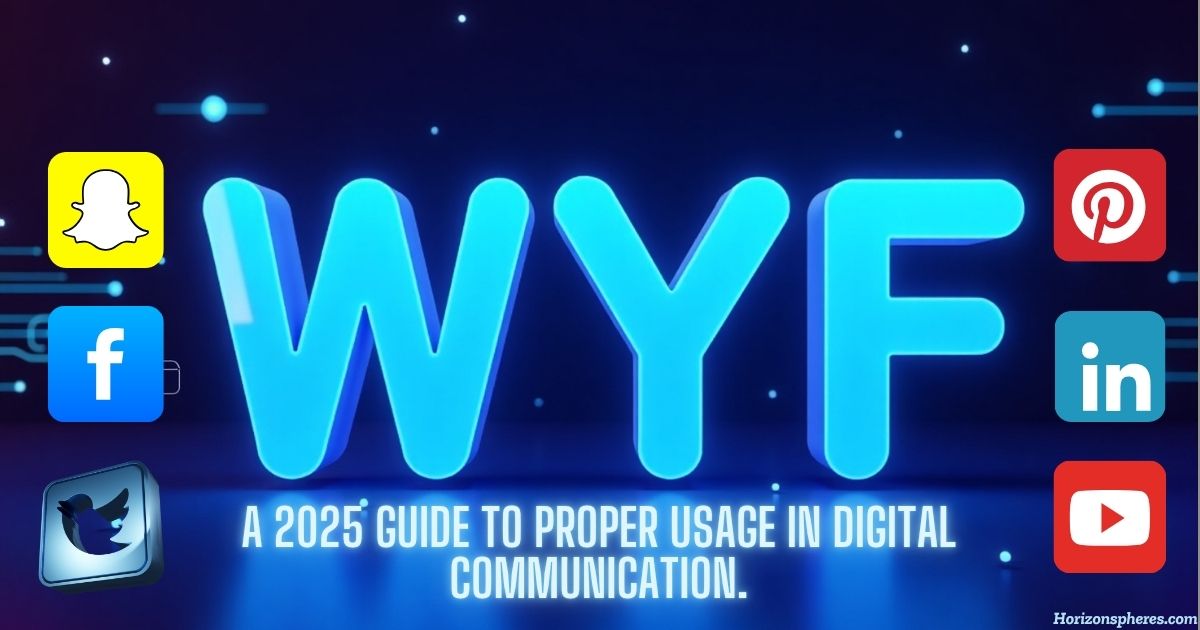Digital communication continues evolving at breakneck speed, introducing countless abbreviations that leave users puzzled. Among these trendy shortcuts, WYF frequently appears across social media platforms, dating apps, and casual messaging.
Understanding this acronym’s proper usage prevents embarrassing miscommunications while enhancing your digital conversation skills. This comprehensive guide explores WYF meaning, appropriate contexts, superior alternatives, and cultural considerations for effective online interactions.
What Does WYF Mean?
WYF stands for “Where You From?” – a casual abbreviation asking about someone’s geographical origin, background, or hometown. This informal phrase dominates text messages, direct messages, and social media comments across platforms like Snapchat, Instagram, TikTok, and dating apps.
Unlike formal inquiries, WYF represents modern slang’s evolution toward brevity over politeness. The abbreviation emerged from gaming communities and quickly spread through youth-oriented platforms, becoming particularly popular among Gen Z users seeking quick conversation starters.
The Digital Landscape: Where WYF Thrives in 2025

Modern communication platforms each embrace WYF differently. What does WYF mean on Instagram? Typically, users employ it in direct messages or comment sections when connecting with new followers. Snapchat users frequently send WYF as conversation openers, while TikTok commenters use it to engage with creators. Dating platforms like Tinder and Bumble see frequent WYF usage as ice-breakers. However, what does wyf mean on wizz follows similar patterns – users asking about geographical locations for potential meetups or cultural exchanges.
| Platform | WYF Usage Context | Appropriateness Level |
| DMs, Comments | Moderate | |
| Snapchat | Direct Messages | High |
| TikTok | Comment Sections | Moderate |
| Dating Apps | Conversation Starters | High |
| Professional Platforms | Business Communication | Low |
When Should You Use WYF?
✅ Appropriate Contexts
WYF works perfectly in casual chats among friends, peer-to-peer conversations, and informal social media interactions. Dating platforms welcome this abbreviation as conversation starters, especially when users share similar interests or locations. Gaming communities, group chats, and casual networking among age-appropriate contacts accept WYF naturally.
What does WYF mean from a girl? Usually, it indicates genuine curiosity about background or potential romantic interest, depending on conversation context and relationship dynamics.
❌ Inappropriate Situations
Professional communication, work-related emails, and business networking require more respectful alternatives. Speaking with authority figures, older relatives, or formal contacts demands polite phrasing over abbreviations. Academic settings, job interviews, and cultural sensitivity situations need thoughtful approaches.
Remote work environments and cross-cultural conversations benefit from inclusive language rather than potentially confusing slang that might seem interrogative or suspicious.
Why WYF Can Be Misinterpreted
Digital communication lacks body language and vocal tone, making WYF appear abrupt or demanding. Recipients might perceive it as suspicious without context. Cultural backgrounds influence interpretation – some view direct questioning about origins as intrusive. Textual tone challenges create misunderstandings when WYF seems interrogative rather than friendly.
Key points:
- Heritage discussions require respectful, culturally aware approaches
- Relationship dynamics matter – strangers feel uncomfortable while friends find it normal
- Professional settings suffer when WYF replaces thoughtful alternatives
- The abbreviation’s brevity eliminates conversational warmth
11 Superior Alternatives to “WYF” (With Examples)

1. “Where are you from?”
This neutral, polite phrasing works universally across platforms and relationships. Perfect for professional networking, social introductions, and cross-cultural conversations. Example: “Nice meeting you! Where are you from originally?” This approach demonstrates respect while maintaining conversational warmth, making recipients comfortable sharing background information.
2. “Which city or country do you call home?”
Warm, inviting language that appeals to travelers and international connections. Ideal for cultural exchanges and heritage discussions. Example: “Your perspective is fascinating – which city or country do you call home?” This phrasing acknowledges mobility while respecting complex identity relationships with multiple locations.
3. “May I ask where you grew up?”
Respectful, formal communication perfect for authority figures and professional settings. Shows boundary awareness and cultural sensitivity. Example: “Your insights suggest diverse experiences – may I ask where you grew up?” This approach demonstrates thoughtfulness while inviting childhood and roots discussions.
4. “Where’s home for you?”
Casual, friendly messaging suitable for peer interactions and social media conversations. Creates personal connection through hometown discussions. Example: “You know great local spots – where’s home for you?” This phrasing feels conversational while maintaining engaging warmth that builds relationships naturally.
5. “Where do you hail from?”
Old-fashioned, thoughtful phrasing that adds charm to conversations. Wyf meaning Old English doesn’t exist, but this alternative provides historical flair. Example: “Such interesting perspectives – where do you hail from?” This approach works well for cultural discussions and heritage conversations requiring reflective tone.
6. “What’s your hometown?”
Neutral, conversational messaging that appeals to younger audiences. Perfect for casual chats and social media interactions. Example: “Love your music taste – what’s your hometown?” This direct yet friendly approach maintains an engaging tone while avoiding WYF’s potential abruptness or misinterpretation.
7. “Where are you based now?”
Professional, formal language ideal for remote work and business networking. Focuses on current location rather than origins. Example: “Interested in collaboration – where are you based now?” This phrasing suits professional contexts while maintaining respectful, engaging communication.
8. “Are you originally from here?”
Curious, soft messaging that creates location-specific conversations. Works well for local community interactions. Example: “You seem to know hidden gems – are you originally from here?” This approach feels natural while demonstrating local knowledge and cultural awareness.
9. “Where’s your background from?”
Cultural, engaging language perfect for heritage and identity discussions. Inclusive approach for diverse communities. Example: “Your name is beautiful – where’s your background from?” This phrasing invites deeper conversations about roots while maintaining a respectful, thoughtful tone.
10. “Where did you grow up?”
Thoughtful, reflective messaging that invites storytelling and personal connection. Perfect for meaningful relationship building. Example: “Your values are inspiring – where did you grow up?” This approach encourages childhood discussions while creating an engaging, warm conversational atmosphere.
11. “Mind if I ask where you’re from?”
Very polite, respectful language ideal for strangers and formal introductions. Shows boundary awareness and cultural sensitivity. Example: “Hope you don’t mind if I ask where you’re from – your perspective is fascinating.” This phrasing demonstrates ultimate respect while maintaining conversational engagement.
How to Choose the Best Alternative to WYF
Selecting appropriate WYF alternatives requires careful audience assessment. Consider the recipient’s age, cultural background, and relationship dynamics before choosing phrasing. Platform analysis matters significantly – Instagram direct messages accept casual language while LinkedIn demands professional communication. Dating platforms welcome friendly approaches, but business emails require formal alternatives. Context evaluation helps determine whether conversations focus on networking, friendship, romance, or professional development.
Cultural sensitivity becomes crucial when discussing heritage, origins, or identity. International connections appreciate inclusive language over potentially confusing abbreviations. Remote work environments benefit from respectful, engaging approaches that build professional relationships. Consider communication tone carefully – warm, conversational language creates better connections than abrupt, direct messaging that might seem interrogative or suspicious.
Why Politeness and Clarity Matter in Digital Communication
- Thoughtful phrasing reduces misinterpretation risks while building stronger relationships across platforms
- Respectful communication demonstrates cultural awareness and interpersonal skills that enhance personal and professional connections
- Clear language prevents confusion, especially in cross-cultural conversations where abbreviations might create misunderstandings
- Engaging approaches foster better responses than abrupt alternatives, creating meaningful dialogues about background, heritage, and personal experiences
- Digital communication evolution demands balance between efficiency and politeness for effective interactions
- Professional reputation benefits from thoughtful language choices that demonstrate respect and cultural awareness
- Platform adaptation requires understanding each environment’s communication norms while maintaining personal authenticity
Cultural Sensitivity and Background Discussions
Navigate heritage conversations with exceptional care across diverse American communities. Regional differences shape communication preferences – some areas favor directness while others prefer respectful, indirect approaches.
Professional settings demand inclusive language welcoming international colleagues and multicultural teams, especially when authority figures expect formal over casual communication.
Respectful Identity Conversations
Approach personal background discussions with warmth and sensitivity, recognizing complex relationships people have with multiple cultures and locations. Create comfortable environments where sharing feels natural rather than pressured.
Building Cultural Understanding
Foster meaningful exchanges by acknowledging that origins can be sensitive topics. Choose appropriate language based on relationship context and cultural awareness to encourage open, judgment-free dialogue.
Common Communication Mistakes and Solutions
Overusing trendy abbreviations like WYF damages relationship-building opportunities through platform confusion and cultural insensitivity. Professional mistakes occur when informal messaging norms inappropriately enter work environments, making recipients uncomfortable or defensive through direct questioning about personal origins and backgrounds.
Avoiding Digital Communication Pitfalls
Recognize when casual abbreviations clash with professional expectations. Adapt language to match recipient comfort levels and avoid applying social media communication styles to workplace or formal interactions.
Effective Recovery Strategies
Acknowledge communication mishaps promptly and adjust your approach accordingly. Use thoughtful follow-up to repair relationships damaged by overly casual messaging, learning from failures to develop stronger digital interpersonal skills.
Frequently Asked Questions
What does wyf mean in a text?
WYF stands for “Where You From” – asking about geographical origin or background.
Are there other meanings for wyf?
Occasionally represents “What’s Your Favorite” in gaming contexts, though rarely used.
What does wyf mean on Reddit?
Typically “Where You From” but context varies by community discussion topics.
What does wyf mean in old English?
No old English meaning exists; it’s a modern digital abbreviation only.
What does WYFM mean in texting?
“Where You From Man” – extended casual version with emphasis added.
What does myf mean from a girl?
Usually “Miss Your Face” in romantic or friendship contexts, unrelated to WYF.
Conclusion
WYF meaning extends beyond simple “Where You From” abbreviation, representing modern digital communication’s evolution toward casual efficiency. However, proper usage requires cultural sensitivity, platform awareness, and audience consideration.
What does WYF mean on Instagram, Snapchat, or TikTok depends entirely on context and relationships involved. Choose thoughtful alternatives like “Where did you grow up?” for more engaging, respectful connections that transcend abbreviated shortcuts while honoring heritage and identity discussions appropriately.










